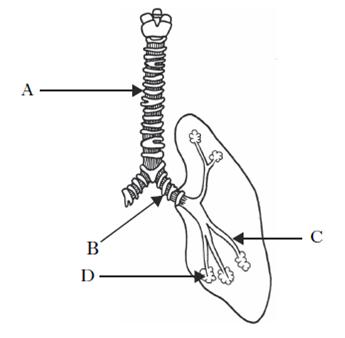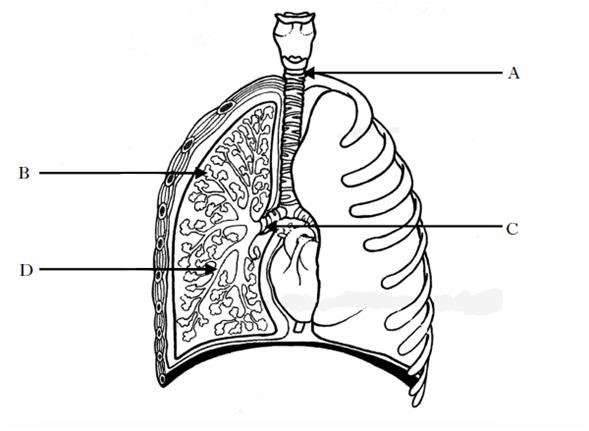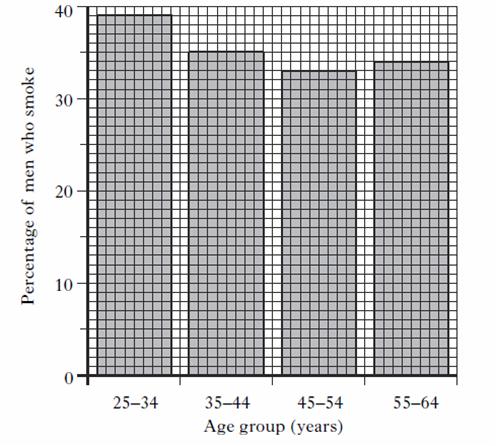| . 1 pt(s). |
The diagram below shows part of the human breathing system. Where does oxygen pass into the blood?
|
||
| A. | A | ||
| B. | B | ||
| C. | C | ||
| D. | D | ||
| . 1 pt(s). |
The diagram below shows part of the breathing system. Which structure is a bronchiole?
|
||
| A. | A | ||
| B. | B | ||
| C. | C | ||
| D. | D | ||
| . 1 pt(s). |
The information in the table refers to some students who took part in an investigation of peak flow. Which factor would be investigated if students 3 and 4 were compared?
|
||
| A. | Age | ||
| B. | Fitness | ||
| C. | Mass | ||
| D. | Sex | ||
| . 1 pt(s). |
The bar graph below shows the percentage of men in different age groups who are smokers. What percentage of 25–34 year old men smoke?
|
||
| A. | 33 | ||
| B. | 34 | ||
| C. | 35 | ||
| D. | 39 | ||
| . 1 pt(s). |
Which line in the table below shows correctly the change in concentrations of oxygen and carbon dioxide in the blood as it passes through the lungs?
|
||
| A. | A | ||
| B. | B | ||
| C. | C | ||
| D. | D | ||
| . 1 pt(s). |
The table below shows the responses of a group of Scottish fifteen year olds when asked about their smoking habits. Which slice of the pie chart represents the percentage of fifteen year olds who are regular smokers?
|
||
| A. | A | ||
| B. | B | ||
| C. | C | ||
| D. | D | ||
| . 1 pt(s). |
Smoking cigarettes can increase the risk of | |
| A. | diabetes | |
| B. | anorexia | |
| C. | cancer | |
| D. | arthritis | |
| . 1 pt(s). |
Four students made two measurements of their vital capacities. The results are shown in the table below. Which student had an average vital capacity of 4100 cm3?
|
||
| A. | A | ||
| B. | B | ||
| C. | C | ||
| D. | D | ||
| . 1 pt(s). |
Peak flow can be used in the diagnosis and management of | |
| A. | asthma | |
| B. | diabetes | |
| C. | heart disease | |
| D. | leukaemia | |
| . 1 pt(s). |
WThe best way to measure someone’s peak flow is to | |
| A. | get the person to breathe out as fast as possible three times and use the highest | |
| B. | get the person to breathe out as fast as possible three times and use the average of the three | |
| C. | get the person to breathe out for as long as possible three times and use the highest | |
| D. | get the person to breathe out for as long as possible three times and use the average of the three values | |
| . 1 pt(s). |
A spirometer is used to measure | |
| A. | peak flow | |
| B. | vital capacity | |
| C. | the size of the lungs | |
| D. | the height of churches | |
| . 1 pt(s). |
Heart rate is measured in | |
| A. | ml per minute | |
| B. | cubic centimetres | |
| C. | beats per minute | |
| D. | beats per 20 seconds | |
| . 1 pt(s). |
The site of gas exchange in the lungs is the | |
| A. | trachea | |
| B. | bronchus | |
| C. | air sac | |
| D. | diaphragm | |





